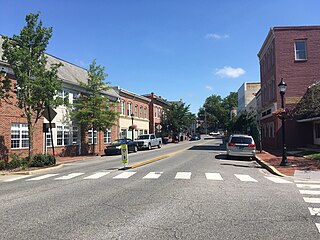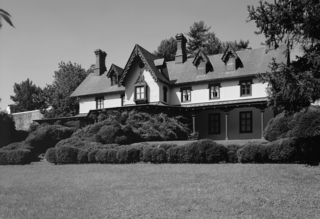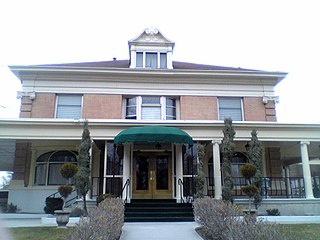
Lewes is an incorporated city on the Delaware Bay in eastern Sussex County, Delaware, United States. According to the 2020 census, its population was 3,303. Along with neighboring Rehoboth Beach, Lewes is one of the principal cities of Delaware's rapidly growing Cape Region. The city lies within the Salisbury, Maryland–Delaware Metropolitan Statistical Area. Lewes proudly claims to be "The First Town in The First State."

Milford is a city in Kent and Sussex counties in the U.S. state of Delaware. According to the 2020 census, the population of the city is 11,190 people and 4,356 households in the city.

Bridgeville is a town in Sussex County, Delaware, United States. According to the 2010 census, the population is 2,048, an increase of 42.6% from the previous decade. It is part of the Salisbury, Maryland-Delaware Metropolitan Statistical Area.

Seaford is a city located along the Nanticoke River in Sussex County, Delaware, United States. According to the 2010 Census Bureau figures, the population of the city is 6,928, an increase of 3.4% from the 2000 census. It is part of the Salisbury, Maryland-Delaware Metropolitan Statistical Area.

Shirley Plantation is an estate on the north bank of the James River in Charles City County, Virginia. It is located on scenic byway State Route 5, between Richmond and Williamsburg. It is the oldest active plantation in Virginia and the oldest family-owned business in North America, dating back to 1614, with operations starting in 1648. It used about 70 to 90 slaves at a time for plowing the fields, cleaning, childcare, and cooking. It was added to the National Register in 1969 and declared a National Historic Landmark in 1970.

David Hazzard was an American merchant and politician from Milton, in Sussex County, Delaware. He was a member of the Democratic-Republican Party, then the National Republican Party, and finally the Whig Party. He served in the Delaware General Assembly, as Governor of Delaware, and as an associate justice of the Delaware Superior Court.

William Henry Harrison Ross was an American politician from Seaford, in Sussex County, Delaware, United States. He was a member of the Democratic Party who served as Governor of Delaware.

The Grange Estate, also known as Maen-Coch and Clifton Hall, is a historic mansion built by Henry Lewis Jr. (1671–1730) in Havertown, Pennsylvania, near Philadelphia, in Delaware County, Pennsylvania. Parts of a c. 1700 residence may be incorporated in the carriage house.

The Judah P. Benjamin Confederate Memorial at Gamble Plantation Historic State Park, also known as the Gamble Mansion or Gamble Plantation, is a Florida State Park, located in Ellenton, Florida, on 37th Avenue East and US 301. It is home to the Florida Division United Daughters of the Confederacy (UDC).

The Mansion Row Historic District is a national historic district located at New Albany, Indiana. It features some of the various mansions of the city when New Albany was the largest city in Indiana around the time of the American Civil War. The main section is on Main Street from State Street, to 15th Street. A smaller section is on Market Street from E. 7th Street to E. 11th Street.

The Gov. William Aiken House was built in 1820 at 48 Elizabeth Street, in the Wraggborough neighborhood of Charleston, South Carolina. Despite being known for its association with Gov. William Aiken, the house was built by John Robinson after he bought several lots in Mazyck-Wraggborough in 1817. His house was originally configured as a Charleston single house with entrance to the house from the south side along Judith Street. The house is considered to be the best preserved complex of antebellum domestic structures in Charleston. It was the home of William Aiken, Jr., a governor of South Carolina, and before that the home of his father, the owner of South Carolina Canal and Railroad Company, William Aiken.

Rose Hill Plantation State Historic Site is a historic site in Union County, South Carolina, that preserves the home of William H. Gist (1807-1874), the 68th governor of South Carolina. Gist helped instigate a Secession Convention in South Carolina, which led to the creation of the Ordinance of Secession that preceded the Civil War.

Woodlawn, is a historic slave plantation located at Columbia, Howard County, Maryland. It is a two-story, stuccoed stone house built in 1840 with wood frame portions constructed about 1785. It was part of a 200-acre farm divided from larger parcels patented by the Dorsey family. The design reflects the transition between the Greek Revival and Italianate architecture styles. The home is associated with Henry Howard Owings, a prominent Howard County landowner and farmer, who also served as a judge of the Orphan's Court for Howard County. Owings purchased the property in 1858 and died at Woodlawn in 1869. The former tobacco farm produced corn, oats, hay, and pork. The majority of the property surrounding Woodland and its slave quarters were subdivided by 1966 and purchased by Howard Research and Development for the planned community development Columbia, Maryland, leaving only 5 acres surrounded by multiple lots intended for development of an Oakland Ridge industrial center and equestrian center. The summer kitchen, smokehouse, corn crib and stable built about 1830 have been replaced by a parking lot.

Old Christ Church, also known as Old Lightwood, is a historic Episcopal church near Laurel, Sussex County, Delaware. The 1772 church resembles its parent church, Green Hill Church of Stepney Parish in Wicomico County, Maryland, except that while Stepney was built in brick, Christ Church is of wood construction. Its weathered appearance gave rise to a nickname "Old Lightwood," although it now is painted barn red.

The Dr. John R. Drish House, also known simply as the Drish House, is a historic plantation house in Tuscaloosa, Alabama, United States. It is considered by state preservationists to be one of the most distinctive mixes of the Greek Revival and Italianate styles in Alabama. First recorded by the Historic American Buildings Survey in 1934, it was added to the Alabama Register of Landmarks and Heritage on July 31, 1975, and subsequently to the state's "Places in Peril" listing in 2006. It was listed as Jemison School-Drish House on the National Register of Historic Places in 2015.

The Jesse Knight House, also known as the Knight Mansion, is a historic house in Provo, Utah, United States built for Jesse Knight. It was built in 1905, and added to the National Register of Historic Places in 1982. This home was designated to the Provo City Historic Landmarks Register on June 19, 1996.

Maston House, also known as Cannon's Savannah, is a historic home located near Seaford, Sussex County, Delaware. It was built in 1727 and enlarged in 1733. It is a 1+1⁄2-story, single pile, brick structure with a gable roof in the "Resurrection Manor" style. As such, it resembles Maryland rather than Delaware houses. It has shed-roof dormers. The interior has wide floor boards and a narrow enclosed staircase winding around the chimney. It is one of Sussex County's oldest brick structures. A small frame addition from the 1970s is attached to the northern end.

Parson Thorne Mansion, also known as Silver Hill, is a historic mansion located at Milford, Kent County, Delaware. The mansion is located across from the Mill House. It was built between 1730 and 1735, and is a two-story, five-bay, center hall brick dwelling in the Georgian style. It has flanking one-story wings and a two-story frame rear wing. The house was remodeled in 1879, and features a steeply pitched cross-gable roof with dormers. It was the home of Delaware Governor William Burton (1789–1866) and the boyhood home of statesman John M. Clayton (1796–1856).

The Davis-Felton Plantation, near Henderson in Houston County, Georgia, is a plantation that was listed on the National Register of Historic Places in 1979. It is located northwest of Henderson on Felton Rd. The plantation was also known as Mossy Hill.

























